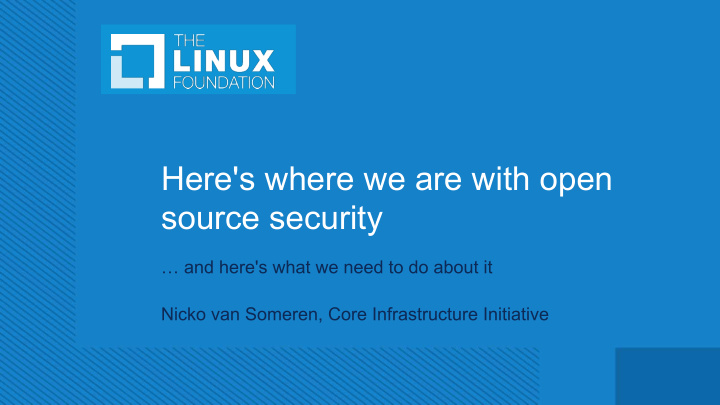



Here's where we are with open source security … and here's what we need to do about it Nicko van Someren, Core Infrastructure Initiative
2014 was a bad year for FOSS security
The Linux Foundation created the Core Infrastructure Initiative with support from 19 Industry Giants
Core Infrastructure Initiative Mission ▪ The CII aims to substantially improve security outcomes in the FOSS projects that underpin the Internet ▪ The CII funds work in security engineering, security architecture, tooling, testing and training on key FOSS projects, as well as supporting general development on security-specific projects (such as crypto libraries)
Security Is Hard For Open or Closed Source - These Are Complex Systems
FOSS Security Is Different FOSS is not more or less secure, but it is different • Typically there are many more people contributing • Sometimes (often?) there is a culture of “code is more important than specification” • Processes are often more ad hoc • There may be less market pressure to put security first
Linus’s Law: “Given enough eyeballs, all bugs are shallow.”
What if you don’t have enough eyeballs?
Where is FOSS security in 2016 ▪ Things are better than 2014 … but we still have a long way to go ▪ Heartbleed, Shellshock, Poodle, ntpd DDoS etc. were a wake-up call to the open source projects as well as for users and the technology industry ▪ Security has become a higher priority for many projects
The state of affairs is still highly variable ▪ Some projects have excellent security process and outcomes ▪ Many are OK ▪ Some are terrible ▪ Quite a lot simply don’t have anyone working on them
Identifying potential sources of risk ▪ Orphan code in deployment is a problem • Ubuntu has nearly 50,000 packages recursively dependent on zlib; the last release was in 2013 ▪ Some projects have higher bug densities than others ▪ Code that runs with privileges is potentially more dangerous ▪ Code in memory-unsafe languages is more prone to certain types of dangerous bug
Identifying at risk projects
Making progress ▪ Direct investment has improved bug security process and security outcomes in many projects: • OpenSSL, GnuPG, OpenSSH and many more ▪ NTPSec fork has removed 75% of the code in ntpd without compromising the functionality ▪ Census project has allowed us to identify and target packages that are at risk ▪ Reproducible builds is allowing users to check binaries ▪ Badging has improved security process in 100s of projects
The impact of the CII ▪ The CII has directly invested in dozens of projects • Typical distributions have 20,000+ packages • We are only scratching the surface in direct investment ▪ Some of our projects have very wide reach • The Fuzzing Project has tested and reported bugs on hundreds of projects • Reproducible Builds has tested ALL 23,931 Debian ‘testing’ source packages
Reproducible Builds: Debian at 91.5%
Successes with OpenSSL Governance ▪ Bugs are found faster and closed faster ▪ More progress on security roadmap items ▪ New release policies mean security updates are being deployed more quickly
Where do we go next? ▪ Many bugs are staying unfixed for too long ▪ Many projects still resist any security improvements that impact performance ▪ Still too much orphan code in use
Kees Cook’s Linux bug time line Critical and high-severity security bugs in the upstream kernel have lifespans from 3.3 to 6.4 years between commit and discovery.
A cost worth paying ▪ Many of the well known and well understood ways to mitigate against the impact of security vulnerabilities have performance costs ▪ Deploying techniques for isolation and self-protection can significantly reduce the risk of harm from whole classes of bug, not just from individual, identified bugs ▪ Projects (and users) need to realise that these costs are worth paying
Security is a process, not a product ▪ Projects like the CII Best Practice Badge have been encouraging projects to think more about their security process ▪ Even mature, well-run projects have been benefitting ▪ This requires buy-in from the whole project community
Scaling up the impact of the CII ▪ Tools for testing • OWASP ZAP ▪ Tools for assessment • Fuzzing ▪ Tools for promoting best practices • Badging ▪ Tools for training
The future of FOSS security ▪ Need to win hearts and minds ▪ No one size fits all ▪ Find the projects that matter ▪ Assess their status ▪ Work out what they need ▪ Provide it
Conclusions ▪ In short, things are getting better but we still have a long way to go ▪ If Open Source software is to become the dominant force in corporate IT then security must be a core selling point ▪ Security must be something that projects thing about early and often and they must be willing to prioritise it as highly as other features
Thank you. https://www.coreinfrastructure.org
Recommend
More recommend